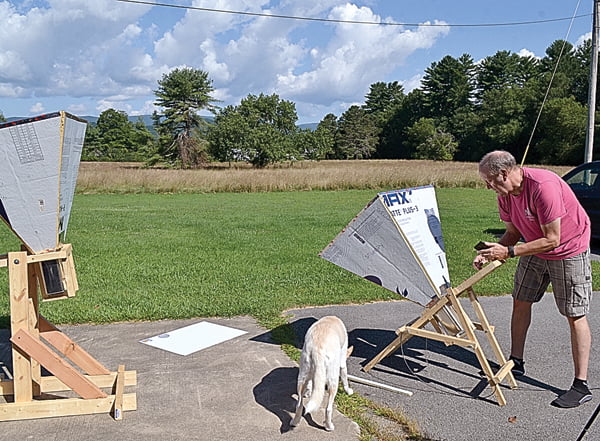
Suzanne Stewart
Staff Writer
For two weeks this summer, a crop of horn-shaped objects have been visible at the old director’s house at the Green Bank Observatory, leading many motorists driving by to wonder – what is going on there?
The simple answer is “research.”
The horn-shaped objects are homemade telescopes, created by high school science teachers participating in a six-week program – DSPIRA [Digital Signal Process in Radio Astronomy] – offered through West Virginia University and the GBO, funded by the National Science Foundation.
The objects – while made from simple materials from a hardware store – are, in fact, telescopes, much like the Green Bank Telescope, but smaller, cheaper and portable.
After making the telescopes, the teachers tried them out and came up with projects to use them in the classroom.
“We can do all kinds of stuff,” John Makous, of North Carolina, said. “We had about nine of them out there – mapping the sky for hydrogen. We’re able to do a lot of what the big telescopes can do, and we’re trying to figure out what all we can we do with these things.
“It’s just phenomenal, because we don’t have to be in the Radio Quiet Zone to do this,” he continued. “I can take my horn back and show it to my students. We can get the spectra and do what we’re doing here. It’s really powerful.”
The horns themselves may not be as impressive, looks-wise, as the telescopes, but once they are hooked to a laptop, they are able to show off their power.
“If you look at the horn, it doesn’t look like it’s anything too spectacular, and that’s the design,” Makous said. “We want it to be made out of materials that you can get locally, like at a Home Deport or something. Any teacher can build it and use it at their school. That’s the goal.”
The software used with the telescopes is also free, which makes it feasible to incorporate the project into a classroom setting.
“We use a program called Stellarium and that tells us where the Milky Way is going to be in the sky at night, and then we point our scopes, and we grab data using a program called Gnu Radio,” Bob Baker of California said. “Everything that we have here, we try to make a program that is almost free so you can download the software free.”
Joining Makous and Baker were Ted Hurman, of New York; John Clark, of Florida; Howard Chun, of Rhode Island; and Michael Stover, the lone West Virginian.
One of the projects the teachers worked on was mapping the hydrogen in space to calculate how fast the Earth rotates.
Hurman calibrated his telescope while the group prepared to collect data on laptops. He explained that he first had to capture the temperature of the sky and the Earth to establish a temperature range before pointing the telescope in the right direction for data collection.
With the portable telescopes – or horns – it is possible for the teachers to not only find astronomy projects for their students, but engineering and math, as well.
“It has all kinds of engineering tied into this,” Makous said. “You have the building of the frame, and the students can try to do that. Then there’s the whole computer aspect of it and the electronics. Some students might be interested in doing programming. Then, of course, there’s the astronomy part of it. I have a lot of students who are really interested in astronomy, so this is an opportunity to not only read about it, but actually do it.”
While working on their telescopes and projects, the team of teachers also documented the process to create helpful tips for teachers who want to incorporate the curriculum into their classrooms, but were unable to attend the six-week program this summer.



